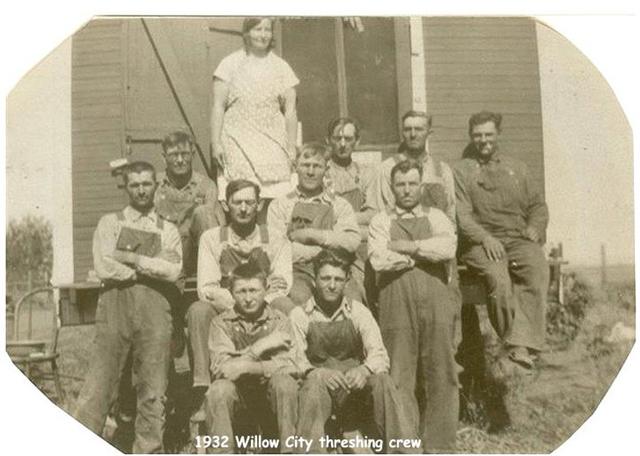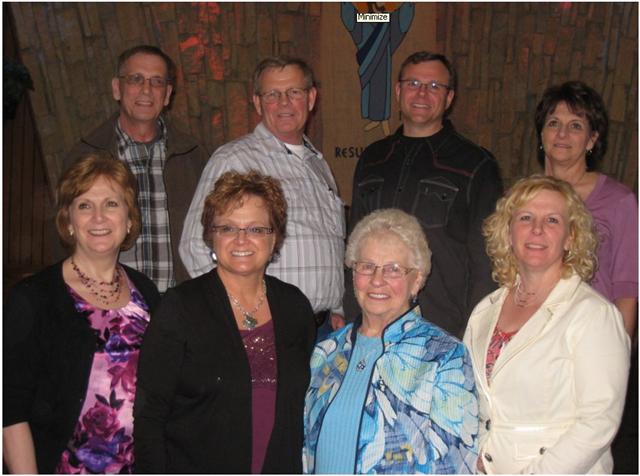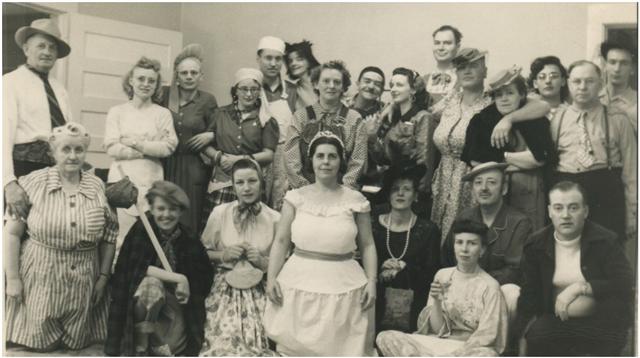Leah Bergeron’s address
One of the guys listed on the back of the threshing picture is Andrew
Stockberger. I believe he is a resident at the Good Sam Nursing Home in
Bottineau. If Neola wants to go talk to him thats fine. It would be
kind of fun to get this one solved. I think the guy sitting next to
Dad is Schultz. One was listed as a Schneider but Wesley had stated
it wasn’t. The lady’s name was Boone. Maybe some of these names will
mean something to somebody. Take care Mary

A couple things on the picture could probably use a little
explanation for folks that aren’t aware of what all is represented in
the picture. The building they are in front of is called a ‘cook car’.
It was a small narrow building that was sitting on large steel wheels
and was pulled by horses from farm to farm. You can see the steel
wheels behind the guys in the picture. This is where the meals were
prepared and there was a long narrow table for the threshing crew to sit
at to eat their meals. The only form of heat for cooking in those days
was a wood fired cook stove. They throw off so much heat into the room
that it’s hard to imagine the temperatures that the women had to endure
to prepare the meals. I bet if it was 80 degrees outside, it would have
easily been well over 100 degrees in the cook car! Those women were a
tough lot. The crew would go from farm to farm threshing crops and each
crew had it’s own cook car. The crew was comprised of bundle haulers
who pitched the binder tied bundles from earlier hand piled ‘shocks’
into hay racks and brought the load to the threshing machine that was
parked in one stationary spot in the field. They pitched the
bundles/shocks onto a feeder housing that took the bundles into the
separator. There was a guy in charge of the feeding operation that I
believe was called the ‘spiker’, although I’m not sure if that was his
only job? There was usually one man in charge of the machine and
another who watched the steam engine that was powering the threshing
machine. This fellow was called the’engineer’. There was a long flat
belt that brought the power from a belt pulley on the engine to the
similar belt pulley on the separator/threshing machine. The threshing
machine had many moving working parts inside it to take the grain
kernels out of the heads of the grain plant and remove the straw which
was blown into a huge straw pile on the field. There were also teams of
horses that pulled wagons to haul the clean grain to the wooden
granaries. I know many of our readers slightly older than those my age,
and some of us my age, remember the days of threshing. Lloyd Awalt and
Floyd Dion, I would wager, both worked on threshing crews as young men
and can give us a first hand account of what it was like. They can
probably correct me too as to what each person’s job was on the crew and
if I have my story straight. The workers/ crew in the old days often
slept in the hay in the barn on the farm they were working on. One of
the guys once told me that even though they made their money, sometimes
just a dollar or two a day, by working long hours threshing the most
sweet sound they would hear was when they would hear rain start on the
roof of the barn as they would get the day off! There were usually
younger kids that had to be up by 4 AM to tend to the horses and get
them ready for the day so I bet they really liked to hear the rain on
the roof! I’ll attach a couple of my grandmothers pictures of threshing
here on our place. In them you can see the crew, cook car, steam engine
with the belt, bundle racks, grain box wagons, straw pile, and the
separator. The guy with the name ‘Louie’ by him is Louis Strietzel, my
grandmother’s brother. You can also see the development from steam
engines to tractors for power and the last picture is of my Grandpa Hans
Johnson with his first combine. This word, ‘combine’ has always puzzled
me as it doesn’t combine–it separates. The story is that the name came
about from the combining of the binder and a separator–thus ‘combine’.
Now we say, “We’re out combining.” Not really.
Lloyd and Floyd, how about some first hand stories of the days on
the threshing crew? Anyone else too please comment. Thanks Gary!
Dick

Lynn Halvorson Otto

Mona Johnson (48)


